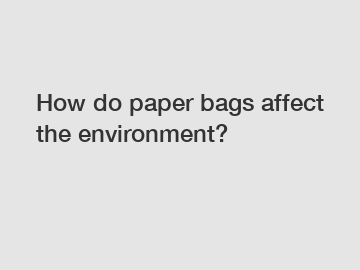How do paper bags affect the environment?
How do Paper Bags Affect the Environment?
In recent years, there has been a growing concern about the impact of plastic bags on the environment. As a result, the focus has shifted towards alternatives such as paper bags. While paper bags are generally considered more eco-friendly than their plastic counterparts, it is important to understand their potential environmental consequences. In this article, we will explore the various ways paper bags affect the environment and shed light on the importance of sustainable choices.
Usage of Raw Materials:

Production of paper bags requires the consumption of natural resources, primarily trees. These trees are usually harvested from forests, which contributes to deforestation – one of the major environmental concerns globally. The demand for paper bags leads to the loss of habitats for many species, disrupting ecosystems and causing a decline in biodiversity. As a result, it is crucial to consider the source of the raw materials used in the production of paper bags, giving preference to sustainably managed forests or even alternative materials.
Energy Consumption and Emissions:
The manufacturing process of paper bags involves high energy consumption and significant greenhouse gas emissions. From harvesting the trees to processing and manufacturing the bags, each stage in the production cycle contributes to the carbon footprint. The energy-intensive production process and the associated emissions add to the overall environmental impact of paper bags. Consequently, it is important to explore more energy-efficient methods and consider renewable energy sources to minimize the environmental footprint of paper bag manufacturing.
Pollution and Waste Management:
Contrary to popular belief, paper bags also contribute to pollution. The bleaching process for paper bags often involves chlorine, which produces toxic chemicals that can contaminate water bodies when not properly treated. Additionally, the disposal of paper bags can lead to issues in waste management. If paper bags are not properly recycled or end up in landfills, they contribute to the generation of greenhouse gases, especially when they decompose without adequate oxygen. This highlights the need for efficient recycling systems and increased consumer awareness about proper waste management practices.
Water Consumption:
The production of paper bags requires a considerable amount of water. From irrigating the trees to the manufacturing process itself, water is a crucial component. Large-scale water consumption for paper production can put a strain on local water sources, especially in regions already facing water scarcity. This can lead to ecological imbalances, affecting aquatic ecosystems and the communities reliant on them. It is important for paper bag manufacturers to implement water conservation measures and explore alternative materials that require less water during production.
Conclusion:
While paper bags are often considered a better alternative to plastic bags, it is essential to recognize their environmental impact. The usage of raw materials, energy consumption, pollution, waste management, and water consumption associated with paper bags all contribute to the overall environmental footprint. If we truly want to minimize our impact on the environment, sustainable choices must be embraced throughout the entire lifecycle of paper bags, from raw material sourcing to disposal. By opting for sustainably sourced materials, improving manufacturing processes, promoting recycling, and practicing responsible waste management, we can mitigate the adverse effects associated with paper bags and move towards a more environmentally friendly future.
If you would like to learn more about sustainable choices or have any questions, please do not hesitate to contact us.
Want more information on Custom Retort Pouches, compostable flexible packaging, health & beauty pouches? Feel free to contact us.

Comments